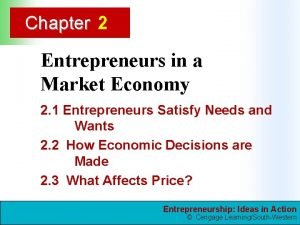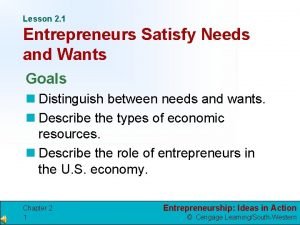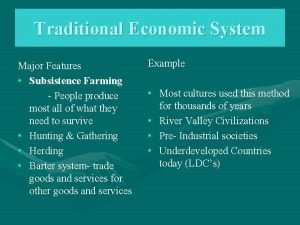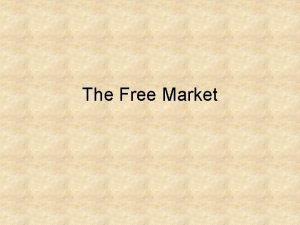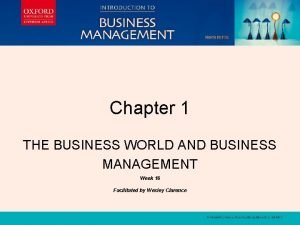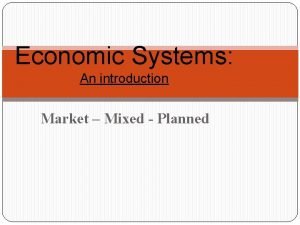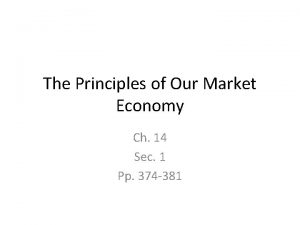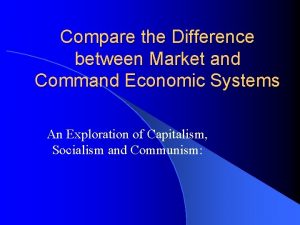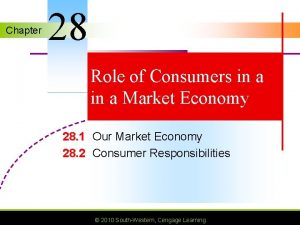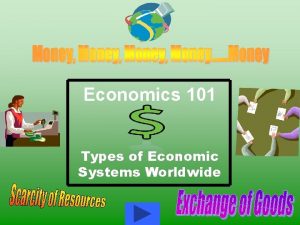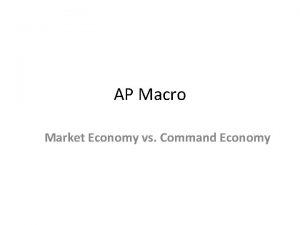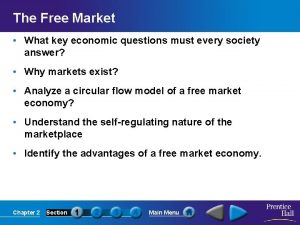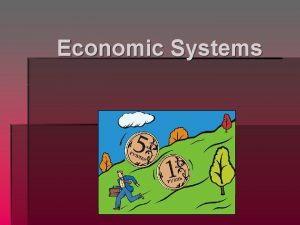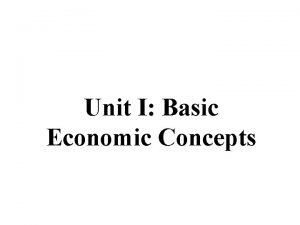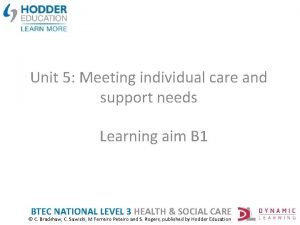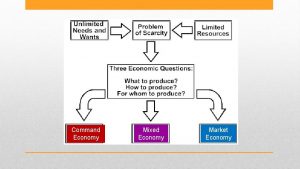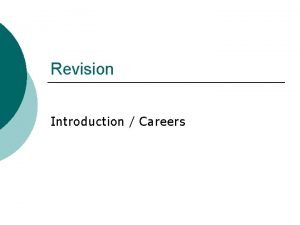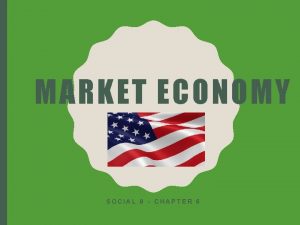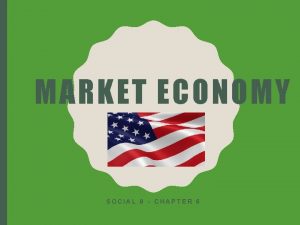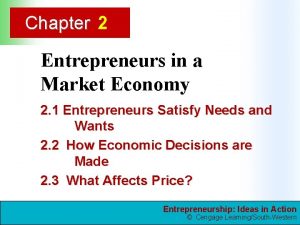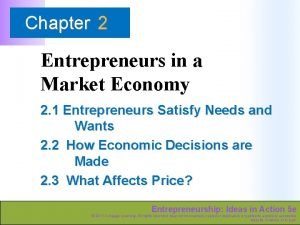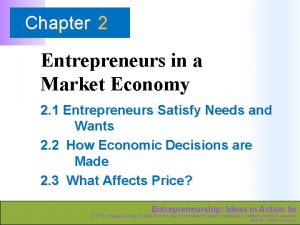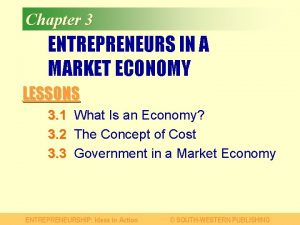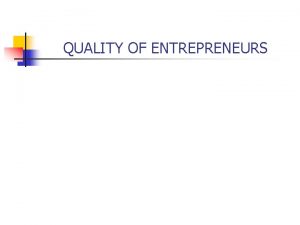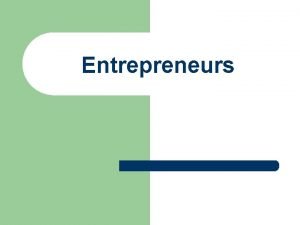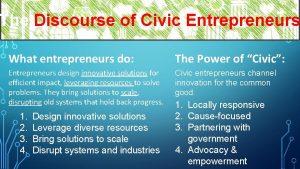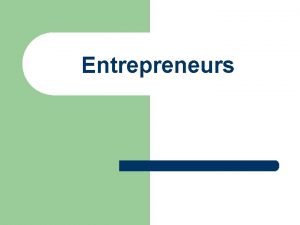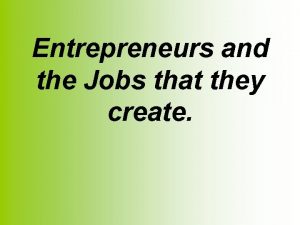Entrepreneurs in a Market Economy Unit 2 Needs




























- Slides: 28

Entrepreneurs in a Market Economy Unit 2

Needs vs Wants • Do you sometimes have a difficult time telling the difference between a need and a want? • Do you think that peer pressure makes it more difficult to distinguish between a need and a want?

Needs vs. Wants • Economics is all about making choices and satisfying the wants and needs of consumers • Your needs are things that you MUST have in order to survive ▫ Good, basic clothing, a place to live • Your wants are things that you THINK you must have in order to be satisfied ▫ Add comfort and pleasure to your life

Needs • People have many needs (basic or higher-level) • Maslow’s hierarchy of needs illustrates the progression people follow in satisfying needs

Wants • Two different types of wants: ▫ Economic Wants: involve a desire for material goods and services �The basis of an economy �Goods such as clothing, housing, and cars �Services such as hair styling and medical care ▫ Non-Economic Wants: the desire for nonmaterial things �Such things as sunshine, fresh air, exercise, friendship, and happiness

Basic Economic Problem • Scarcity: ▫ Your needs and wants never end ▫ You are limited only by what your mind can think of and what business make available for sale ▫ Limited resources for unlimited wants and needs

Economic Resources • The means through which goods and services are produced • Three types: ▫ Natural Resources: raw materials supplied by nature. �Oil, minerals, rivers, lakes, oceans, etc. ▫ Human Resources: the people who create goods and services ▫ Capital Resources: the assets used in the production of goods and services �Buildings, equipment, supplies, money, etc.

Law of Diminishing Returns • States that one factor of production is increased while others stay the same, the resulting increase in output will level off after some time and then will decrease. ▫ Extra workers, extra capital, extra machinery, or land may not necessarily raise output as expected

Economic Systems • All economic systems must answer 3 basic ? s: 1. What goods and services will be produced? 2. How will the goods and services be produced? 3. For whom will the goods and services be produced? • The type of economic system will determine how these three questions are answered ▫ Command, Market, Traditional, Mixed

Economic Systems • Command Economy ▫ The gov’t determines what, how, and for whom goods/services are produced ▫ There is little choice for consumers in what is available • Market Economy ▫ Individuals and businesses decide ▫ Individual choice creates the market �Many items available that are very similar �Products/services are always available to everyone who has the means to pay for them

Economic Systems • Traditional Economy ▫ Goods/services are produced the way they have always been produced ▫ Used in countries that are less developed �Not participating in the global economy • Mixed Economy ▫ Elements of the command market economies are combined ▫ Individuals, businesses, and the gov’t are involved in making decisions in the marketplace


Economic Choices • Scarcity ▫ Decisions based on scarcity affect everyone ▫ Forces you to make choices or decisions �Trade-offs • Opportunity Cost ▫ The value of the next-best alternative—the one you pass up �Example: $300 graduation money

Activity

The Shipwreck • One day 20 people, including the paying customers and crew, set sail on a fishing expedition. After a few hours of peaceful sailing, the ship encountered a terrible storm. • As a result of the storm, the fishing boat sank. Luckily, all 20 people survived, making their way to a small deserted island. • Unfortunately, all the communication equipment went down with the ship so there is no way to signal for help.

The Shipwreck • Once settled on the island, the captain of the fishing boat called the survivors together and said the following. • Here are the facts about our situation as I see them: ▫ For better or for worse, the 20 of us will be spending days, weeks, or maybe years together ▫ We all have different needs and wants ▫ In order to survive, we have to depend on each other, even though some of us are smarter, some have more money, & some are more skilled

The Shipwreck • Finally, and most important, there are three fundamental questions we have to answer to determine how we will meet the various needs and wants each of us have: 1. What goods/services should we produce? 2. How should they be produced? 3. Who should receive the goods/services produced?

Activity • If you were the president of a newly independent nation, ▫ what is one element of traditional economies, ▫ one element of capitalistic economies, and ▫ one element of command economies that you would like to bring to your nation?

What Affects Price? • Consumers and produces determine quantities and prices of goods/services produced • Two important forces: ▫ Supply: the quantity of a good/service a producer is willing to produce at different prices ▫ Demand: the quantity of a good/service that consumers are willing to buy at a given price

Supply and Demand Curves

Demand Elasticity • Demand Elasticity: When the demand for a product is affected by its price �When a change in price creates a change in demand, you have elastic demand �When a change in price creates very little change in demand, you have inelastic demand • Demand is usually inelastic when: ▫ There are no acceptable substitutes ▫ The change in price is small in relation to the income of the consumer ▫ The product is a basic need for consumers (not a want)

When Supply and Demand Meet

Costs of Doing Business • To determine how much profit you are earning, you need to know how much it costs to produce • You must consider ALL the resources that go into producing the good/service • Fixed Costs: must be paid regardless of how much of a good/service is produced ▫ Also called sunk costs • Variable Costs: costs that go up and down depending on the quantity being produced

Marginal Benefit and Marginal Cost • Marginal Benefit: measures the advantages of producing one additional unit of a good/service • Marginal Costs: measures the disadvantages of producing one additional unit of a good/service ▫ Example staying open late to sell more

Economies of Scale • When a business owner decides to grow the business, s/he needs to consider the economies of scale ▫ The cost advantages obtained due to expansion • Economies of scale represent an increase in efficiency of production as the number of units of goods produced increases ▫ A business that achieves economies of scale lowers the average cost per unit through increase production

Market Structure • Determined by the nature and degree of competition among businesses in the same industry • Main criteria: ▫ Number and size of sellers and buyers in the market ▫ The type of goods/services being traded ▫ The barriers to enter into the market for sellers

Comparing Market Types Type of Market # of Kind of Producers Competition Barriers to Entry Special Traits One No entry possible Only one firm A few Primarily nonprice competition Medium barriers (difficult entry) Firms can collude and behave as a monopolist Monopolistic Competition Many Non-price competition; price competition Low barriers (easy entry Product differentiation and branding Perfect Competition A great many Price competition No barriers (free entry) Perfectly elastic demand Monopoly Oligopoly

Assingment • Complete the Vocabulary Builder and the Review Your Knowledge section at the end of Chapter 2 ▫ Page 59 -60 of the book, page 24 -25 on the PDF • Complete Question #23 in the Apply What you Learned section ▫ Page 60 of the book, page 25 on the PDF • Type all in one Google. Docs and send to me when done.
 Chapter 2 entrepreneurs in a market economy
Chapter 2 entrepreneurs in a market economy Are entrepreneurs encouraged in a traditional economy
Are entrepreneurs encouraged in a traditional economy Satisfying needs 2
Satisfying needs 2 Athenian economy vs sparta economy
Athenian economy vs sparta economy Market follower
Market follower Segmentation targeting positioning
Segmentation targeting positioning Primary needs and secondary needs
Primary needs and secondary needs Satisfaction
Satisfaction Alpha press murray
Alpha press murray Strategic gender needs and practical gender needs
Strategic gender needs and practical gender needs Difference between target needs and learning needs
Difference between target needs and learning needs Traditional economic system example
Traditional economic system example Free market economy characteristics
Free market economy characteristics The need-satisfying institutions of the market economy
The need-satisfying institutions of the market economy Characteristics of market economy
Characteristics of market economy Faming
Faming Principles of market economy
Principles of market economy Similarities between market and command economy
Similarities between market and command economy Chapter 28 role of consumers in a market economy
Chapter 28 role of consumers in a market economy Market economy
Market economy Market vs command economy
Market vs command economy Market economy
Market economy Which statement best describes a pure market economy?
Which statement best describes a pure market economy? Market economy
Market economy Free market economy
Free market economy Free market economy
Free market economy Market directed economy
Market directed economy Unit 6 review questions
Unit 6 review questions Meeting individual care and support needs
Meeting individual care and support needs
